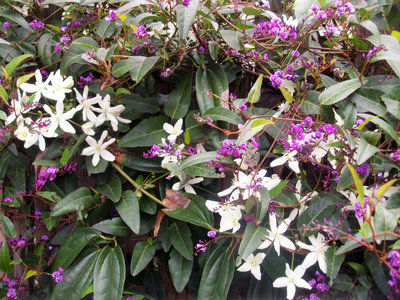
If you enjoy fragrance in your garden and beautiful blooms, you can have them both when you plant vines.
Vines are amazing plants. They use little space, add color to bare walls and fences, cover free-standing arbors, provide shade and extend the garden skyward.
If your trees aren’t big enough to provide shade yet, vines twined around on a pergola or along lattice work can cool a west-facing patio. They can also block the wind, making your garden more comfortable. Vines with large, soft leaves can gentle sounds that would otherwise bounce off hard surfaces. Birds will love you for your vines, too: They offer shelter for many species and nectar for others.
Creating an outdoor room using vines can make your yard feel cozy. Given simple supports, they readily provide the walls to enclose the space. Views from a given part of the garden may be partially open, framed by vines or blocked entirely. Shrubs can also be used to create garden rooms, but vines form a thin, living wall that is quickly established. Creating boundaries with vines also adds vertical design elements to an otherwise flat landscape.
Burdened with an unattractive view? Conceal it by planting vines at its base. A dog house, old stump or rock pile can become a pleasant view when it’s covered with twining leaves and blossoms. Disguising a concrete block retaining wall with a climbing hydrangea will reward you with a great show of flowers each spring. Boston ivy or a native vine like Roger’s Red wild grape would provide fall color on the same wall.
Planting vines in containers or planters on a deck, balcony or paved area can add beauty to these areas, too. Remember that large containers offer more root space than small pots and require less frequent watering and transplanting. Vines, of course, need support to climb. A small lattice structure or netting stretched between posts works well for vines such as clematis and pink jasmine. The structure doesn’t need to be in the container.
Combining vines can have twice the effect. A classic combination is to plant a large flowering clematis, such as Jackmanii, with a rambling rose. I’ve seen these on arbors and split-rail fences, and the look is breathtaking.
For a vine with long-lasting interest, try trumpet creeper, which blooms from midsummer to early autumn. Hummingbirds love it. Growing in sun or shade, it can tolerate wet or dry conditions and is generally pest free. Just give it lots of space to grow.
Climbing hydrangea has showy white spring flowers and bright-yellow autumn color before the leaves fall. During the winter months, the peeling bark provides interest. It thrives with a bit of shade and regular moisture. This is an excellent choice for masonry walls and the trunks of mature trees. It will clothe a wall with white flowers and turn a dull trunk into a floral masterpiece.
In addition to visual interest, plant vines for fragrance in your garden. Evergreen clematis bears fragrant white flower clusters above shiny, dark green leaves in spring. Montana clematis is covered with vanilla-scented pink flowers in spring also. Carolina jessamine’s fragrant yellow flowers appear in masses throughout late winter into spring.
Star jasmine is a wonderful vine for sun or shade, and its intense fragrance near a patio or open window will delight you. It is easy to grow and generally is not troubled by pests. Pink jasmine blooms mostly in the spring but also sporadically through fall, with showy, sweet-scented pale pink flowers. It grows quickly to 15 feet and is tolerant of drought. It can also be allowed to cascade over a wall or from a hanging basket.
Other vines that are beautiful and easy to grow are the native honeysuckle, lonicera hispidula, with its translucent red berries in the fall. Violet trumpet vine, white potato vine, passionflower, Lady Banks rose, hardenbergia, Chilean jasmine and wisteria are other good choices.
The above vines are just a few of the wonderful vines that do well in our climate, in a wide range of soils and conditions. They are resistant to pests and need little fertilization or care, other than pruning to control size, if needed. Look around your garden for a spot that would be enhanced by a beautiful vine.
Jan Nelson, a landscape designer and California certified nursery professional at Plant Works in Ben Lomond, will answer questions about gardening in the Santa Cruz Mountains. Contact her at ja******@*ol.com or JanNelsonLandscapeDesign.com.










